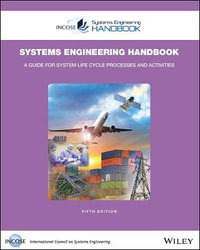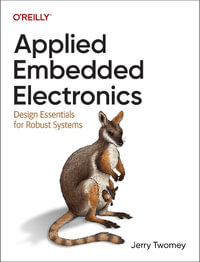
Advanced Testing of Systems-of-Systems, Volume 1
Theoretical Aspects
By: Bernard Homès
Hardcover | 16 May 2023 | Edition Number 1
At a Glance
320 Pages
24.0 x 16.3 x 2.1
Hardcover
RRP $273.95
$161.75
41%OFF
or 4 interest-free payments of $40.44 with
orAims to ship in 7 to 10 business days
As a society today, we are so dependent on systems-of-systems that any malfunction has devastating consequences, both human and financial. Their technical design, functional complexity and numerous interfaces justify a significant investment in testing in order to limit anomalies and malfunctions.
Based on more than 40 years of practice in the development and testing of systems, including safety-critical systems, this book discusses development models, testing methodologies and techniques, and identifies their advantages and disadvantages.
Pragmatic and clear, this book displays many examples and references that will help you improve the quality of your systemsof-systems efficiently and effectively and lead you to identify the impact of upstream decisions and their consequences.
Advanced Testing of Systems-of-Systems 1 is complemented by a second volume dealing with the practical implementation and use of the techniques and methodologies proposed here.
Dedication and Acknowledgments xiii
Preface xv
Chapter 1 Introduction 1
1.1 Definition 1
1.2 Why and for who are these books? 3
1.2.1 Why? 3
1.2.2 Who is this book for? 4
1.2.3 Organization of this book 5
1.3 Examples 5
1.4 Limitations 7
1.5 Why test? 7
1.6 MOA and MOE 8
1.7 Major challenges 9
1.7.1 Increased complexity 9
1.7.2 Significant failure rate 12
1.7.3 Limited visibility 12
1.7.4 Multi-sources and complexity 13
1.7.5 Multi-enterprise politics 14
1.7.6 Multiple test levels 16
1.7.7 Contract follow-up, measures, reporting and penalties 18
1.7.8 Integration and test environments 19
1.7.9 Availability of components 20
1.7.10 Combination and coverage 21
1.7.11 Data quality 21
1.7.12 Flows, pivots and data conversions 22
1.7.13 Evolution and transition 23
1.7.14 History and historization 23
1.7.15 Impostors 24
Chapter 2 Software Development Life Cycle 27
2.1 Sequential development cycles 28
2.1.1 Waterfall 29
2.1.2 V-cycle 30
2.1.3 Spiral and prototyping 32
2.1.4 Challenges of sequential developments 34
2.2 Incremental development cycles 34
2.2.1 Challenges of incremental development 35
2.3 Agile development cycles 35
2.3.1 Agile Manifesto 36
2.3.2 eXtreme Programming 39
2.3.3 Challenges of iterative cycles 40
2.3.4 Lean 47
2.3.5 DevOps and continuous delivery 49
2.3.6 Agile development challenges 52
2.4 Acquisition 53
2.5 Maintenance 54
2.6 OK, what about reality? 55
Chapter 3 Test Policy and Test Strategy 59
3.1 Test policy 59
3.1.1 Writing test policy 60
3.1.2 Scope of the test policy 60
3.1.3 Applicability of the test policy 61
3.2 Test strategy 61
3.2.1 Content of a test strategy 63
3.2.2 Test strategies and Taylorism 65
3.2.3 Types of test strategies 66
3.2.4 Test strategy and environments 70
3.3 Selecting a test strategy 71
3.3.1 “Completeness” of the strategy 71
3.3.2 Important points in the strategy 72
3.3.3 Strategy monitoring 73
3.3.4 Shift left, costs and time 74
3.3.5 “Optimal” strategy 76
3.3.6 Ensuring success 77
3.3.7 Why multiple test iterations? 78
3.3.8 Progress forecast 80
3.3.9 Continuous improvements 81
Chapter 4 Testing Methodologies 83
4.1 Risk-based tests (RBT) 83
4.1.1 RBT hypothesis 84
4.1.2 RBT methodology 84
4.1.3 RBT versus RRBT 90
4.1.4 Reactions to risks 90
4.1.5 Risk computation 91
4.1.6 RBT synthesis 97
4.1.7 Additional references 97
4.2 Requirement-based tests (TBX) 97
4.2.1 TBX hypothesis 98
4.2.2 TBX methodology 99
4.2.3 TBX calculation 99
4.2.4 TBX synthesis 100
4.3 Standard-based (TBS) and systematic tests 101
4.3.1 TBS hypothesis 101
4.3.2 TBS calculation 101
4.3.3 TBS synthesis 102
4.4 Model-based testing (MBT) 102
4.4.1 MBT hypothesis 103
4.4.2 MBT calculation 104
4.4.3 MBT synthesis 104
4.5 Testing in Agile methodologies 105
4.5.1 Agile “test” methodologies? 105
4.5.2 Test coverage 105
4.5.3 Hypothesis 112
4.5.4 Calculation methods 114
4.5.5 Synthesis 116
4.6 Selecting a multi-level methodology 116
4.6.1 Hypothesis 117
4.6.2 Calculation 118
4.7 From design to delivery 119
Chapter 5 Quality Characteristics 121
5.1 Product quality characteristics 122
5.2 Quality in use 125
5.3 Quality for acquirers 125
5.4 Quality for suppliers 126
5.5 Quality for users 126
5.6 Impact of quality on criticality and priority 127
5.7 Quality characteristics demonstration 128
5.7.1 Two schools 128
5.7.2 IADT proofs 129
5.7.3 Other thoughts 130
Chapter 6 Test Levels 131
6.1 Generic elements of a test level 132
6.1.1 Impacts on development cycles 133
6.1.2 Methods and techniques 134
6.1.3 Fundamental principles 134
6.2 Unit testing 137
6.3 Component integration testing 139
6.3.1 Types of interfaces to integrate 140
6.3.2 Integration challenges 140
6.3.3 Integration models 141
6.3.4 Hardware–software integration tests 142
6.4 Component tests 143
6.5 Component integration tests 144
6.6 System tests 145
6.7 Acceptance tests or functional acceptance 147
6.8 Particularities of specific systems 148
6.8.1 Safety critical systems 148
6.8.2 Airborne systems 148
6.8.3 Confidentiality and data security 149
Chapter 7 Test Documentation 151
7.1 Objectives for documentation 152
7.2 Conformity construction plan (CCP) 153
7.3 Articulation of the test documentation 153
7.4 Test policy 154
7.5 Test strategy 155
7.6 Master test plan (MTP) 156
7.7 Level test plan 158
7.8 Test design documents 159
7.9 Test case specification 160
7.10 Test procedure specification 160
7.11 Test data specifications 161
7.12 Test environment specification 161
7.13 Reporting and progress reports 161
7.14 Project documentation 162
7.15 Other deliverables 163
Chapter 8 Reporting 165
8.1 Introduction 165
8.2 Stakeholders 167
8.3 Product quality 168
8.4 Cost of defects 168
8.5 Frequency of reporting 170
8.6 Test progress and interpretation 170
8.6.1 Requirements coverage 171
8.6.2 Risk coverage 172
8.6.3 Component or functional coverage 174
8.7 Progress and defects 175
8.7.1 Defect identification 176
8.7.2 Defects fixing 177
8.7.3 Defect backlog 177
8.7.4 Number of reopened defects 179
8.8 Efficiency and effectiveness of test activities 180
8.9 Continuous improvement 181
8.9.1 Implementing continuous improvements 181
8.10 Reporting attention points 184
8.10.1 Audience 184
8.10.2 Usage 185
8.10.3 Impartiality 185
8.10.4 Evolution of reporting 186
8.10.5 Scrum reporting 187
8.10.6 KANBAN reporting 188
8.10.7 Test design reporting 188
8.10.8 Test execution reporting 189
8.10.9 Reporting software defects 190
8.10.10 UAT progress reporting 194
8.10.11 Reporting for stakeholders 194
Chapter 9 Testing Techniques 197
9.1 Test typologies 197
9.1.1 Static tests and reviews 198
9.1.2 Technical tests 198
9.2 Test techniques 199
9.3 CRUD 200
9.4 Paths (PATH) 200
9.4.1 Operation 200
9.4.2 Coverage 204
9.4.3 Limitations and risks 204
9.5 Equivalence partitions (EP) 204
9.5.1 Objective 207
9.5.2 Operation 207
9.5.3 Coverage 207
9.5.4 Limitations and risks 207
9.6 Boundary value analysis (BVA) 207
9.6.1 Objective 208
9.6.2 Operation 208
9.6.3 Coverage 208
9.6.4 Limitations and risks 208
9.7 Decision table testing (DTT) 208
9.7.1 Objective 209
9.7.2 Operation 209
9.7.3 Coverage 212
9.7.4 Limitations and risks 212
9.8 Use case testing (UCT) 212
9.8.1 Objective 212
9.8.2 Operation 213
9.8.3 Coverage 213
9.8.4 Limitations and risks 213
9.9 Data combination testing (DCOT) 214
9.9.1 Objective 214
9.9.2 Operation 214
9.9.3 Coverage 214
9.9.4 Challenge 214
9.10 Data life cycle testing (DCYT) 215
9.10.1 Objective 215
9.10.2 Operation 215
9.10.3 Coverage 215
9.10.4 Challenge 215
9.11 Exploratory testing (ET) 216
9.11.1 Objective 216
9.11.2 Operation 216
9.11.3 Coverage 217
9.11.4 Limitations and risks 217
9.12 State transition testing (STT) 218
9.12.1 Objective 218
9.12.2 Operation 219
9.12.3 Coverage 219
9.13 Process cycle testing (PCT) 219
9.13.1 Objective 219
9.13.2 Operation 219
9.13.3 Coverage 220
9.13.4 Limitations and risks 220
9.14 Real life testing (RLT) 221
9.14.1 Objective 221
9.14.2 Operation 221
9.14.3 Coverage 222
9.14.4 Limitations and risks 222
9.15 Other types of tests 223
9.15.1 Regression tests or non-regression tests (NRTs) 223
9.15.2 Automated tests 224
9.15.3 Performance tests 225
9.15.4 Security tests 226
9.16 Combinatorial explosion 227
9.16.1 Orthogonal array testing (OAT) 228
9.16.2 Classification tree testing (CTT) 229
9.16.3 Domain testing (DOM) 230
9.16.4 Built-in tests (BIT, IBIT, CBIT and PBIT) 231
Chapter 10 Static Tests, Reviews and Inspections 233
10.1 What is static testing? 235
10.2 Reviews or tests? 236
10.2.1 What is a review? 236
10.2.2 What can be subjected to reviews? 236
10.3 Types and formalism of reviews 237
10.3.1 Informal or ad hoc reviews 239
10.3.2 Technical reviews 239
10.3.3 Checklist-based reviews 240
10.3.4 Scenario-based reviews 240
10.3.5 Perspective-based reviews (PBRs) 241
10.3.6 Role-based reviews 241
10.3.7 Walkthrough 241
10.3.8 Inspections 241
10.3.9 Milestone review 242
10.3.10 Peer review 242
10.4 Implementing reviews 242
10.5 Reviews checklists 243
10.5.1 Reviews and viewpoint 243
10.5.2 Checklist for specifications or requirements review 244
10.5.3 Checklist for architecture review 245
10.5.4 Checklist for high-level design review 247
10.5.5 Checklist for critical design review (CDR) 248
10.5.6 Checklist for code review 250
10.6 Defects taxonomies 251
10.7 Effectiveness of reviews 252
10.8 Safety analysis 253
Terminology 255
References 263
Index 269
Summary of Volume 2 271
ISBN: 9781786307491
ISBN-10: 1786307499
Published: 16th May 2023
Format: Hardcover
Language: English
Number of Pages: 320
Audience: Professional and Scholarly
Publisher: John Wiley & Sons Inc (US)
Country of Publication: GB
Edition Number: 1
Dimensions (cm): 24.0 x 16.3 x 2.1
Weight (kg): 0.63
Shipping
| Standard Shipping | Express Shipping | |
|---|---|---|
| Metro postcodes: | $9.99 | $14.95 |
| Regional postcodes: | $9.99 | $14.95 |
| Rural postcodes: | $9.99 | $14.95 |
How to return your order
At Booktopia, we offer hassle-free returns in accordance with our returns policy. If you wish to return an item, please get in touch with Booktopia Customer Care.
Additional postage charges may be applicable.
Defective items
If there is a problem with any of the items received for your order then the Booktopia Customer Care team is ready to assist you.
For more info please visit our Help Centre.
You Can Find This Book In

Structural Health Monitoring Using Emerging Signal Processing Approaches with Artificial Intelligence Algorithms
Hardcover
RRP $315.00
$222.90
OFF

Hybrid Communication Systems for Future 6G and Beyond
Visible Light Communication and Radio over Fiber Technology
Hardcover
RRP $228.75
$188.90
OFF

INCOSE Systems Engineering Handbook
5th Edition - A Guide for System Life Cycle Processes and Activities
Paperback
RRP $149.95
$92.50
OFF




















